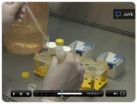(Press-News.org) The ranking of a monkey within her social environment and the stress accompanying that status dramatically alters the expression of nearly 1,000 genes, a new scientific study reports. The research is the first to demonstrate a link between social status and genetic regulation in primates on a genome-wide scale, revealing a strong, plastic link between social environment and biology.
In a comparison of high-ranking rhesus macaque females with their low-ranking companions, researchers discovered significant differences in the expression of genes involved in the immune response and other functions. When a female's rank improved, her gene expression also changed within a few weeks, suggesting that social forces can rapidly influence genetic regulation.
"We were able to use gene expression to classify individuals based on their rank," said Yoav Gilad, PhD, associate professor of human genetics at the University of Chicago Biological Sciences and senior author of the study in PNAS. "Demonstrating these very plastic and temporal changes was novel and quite interesting."
The research, led by University of Chicago postdoctoral researcher Jenny Tung, was conducted with rhesus macaques housed in groups of five at the Yerkes National Primate Research Center in Atlanta. As in the wild, each group self-organizes into a dominance hierarchy, defined by which individual yields first during competition over food, water and grooming partners. In captivity, dominance is determined by the order of introduction into the group, giving researchers an opportunity to study how changes in rank lead to biological effect.
"In the wild, females would not ordinarily leave the social group they were born into," said Tung, PhD, now an assistant professor of evolutionary anthropology at Duke University. "They inherit their social rank from their mothers. But in this unnatural situation, order of introduction determines rank – the newcomer is generally lower status."
Previous research on rhesus macaques discovered that social rank influenced components of the stress response, brain, and immune system. With gene chip technology for measuring the expression of over 6,000 different genes, Tung, Gilad and colleagues at Yerkes, Emory University, and Johns Hopkins looked for the first time in primates at the effects of social rank on genetic function.
Comparing 49 different female monkeys of different rank revealed significant changes in the expression of 987 genes, including 112 genes associated with immune system function. The result fits with data in monkeys where low rank and chronic stress lead to compromised immune function, and, more loosely, with human studies linking low socioeconomic status and high social stress to elevated disease risk.
The overall genetic "signature" of expression changes was robust enough that researchers could predict an individual monkey's social rank with high accuracy from their gene expression profile alone. That predictive power also enabled an unanticipated second test of whether gene expression would reflect unplanned changes in dominance rank.
"It was a fortunate event in the experiment," Gilad said. "When a couple of animals were removed from cages for various reasons and new ones were introduced to the groups, it turned out to improve the rank of a few monkeys. We could take advantage of this switch and see if our classifier still works."
By analyzing blood samples from these monkeys before and after their move, the researchers were able to use gene expression signatures to correctly predict the change in rank for six of seven monkeys. The result demonstrates that socially-induced gene expression changes are not stable, but can change rapidly in response to changes in social environment.
"There's a spooky side to this kind of research, in that an individual's social rank is partially determining health status," Tung said. "But there's also a hopeful side. For the seven females that changed ranks, their gene status changed with them. They're not stuck in place, and I think that says something more broadly about the capacity for change."
The researchers also investigated the mechanisms by which social status could influence gene expression. Dominance rank affected signaling of the glucocorticoid "stress hormone" system and the cell composition of blood samples, both of which contributed to changes in gene expression.
Experiments also demonstrated for the first time that social rank influenced the DNA methylation status of many genes, an epigenetic mechanism of transiently turning genes on and off. Genes that changed expression with rank status were more likely to be methylated than unaffected genes, suggesting that this mechanism also plays a role in the social influence on genetic regulation.
"That's a novel mechanism that people haven't considered in primates," Gilad said. "I know that some have been resistant to the possibility of methylation changes on this timescale, but this is a demonstration that this mechanism also matters."
The authors caution that the experiments used monkeys in captivity, and stressed that the relationship between stress and gene regulation in the wild might not look the same. The influence of social factors on human genetics also remains to be tested, and measuring status while controlling for confounding factors in people would be a difficult endeavor, Gilad said. But if social stress does in fact influence human health, the current research provides some optimism.
"An encouraging message to humans is the fact that the effects are plastic, reversible and change on a really large scale when rank changes," Gilad said. "Whatever it is that causes stress through social environment, you might be able to fix."
### The study, "Social environment is associated with gene regulatory variation in the rhesus macaque immune system," will be published in online in PNAS Early Edition the week of April 9th, 2012. In addition to Tung and Gilad, authors include Luis Barreiro and Kateyln Michelini of the University of Chicago Biological Sciences, Zachary Johnson, Vasiliki Michopoulos, Donna Toufexis and Mark Wilson of Yerkes National Primate Research Center, and Kasper Hansen of Johns Hopkins School of Medicine. Funding for the research was provided by the National Institutes of Health.
For more news from the University of Chicago Medical Center, follow us on Twitter at @UChicagoMed, or visit our Facebook page at facebook.com/UChicagoMed, our research blog at sciencelife.uchospitals.edu, or our newsroom at uchospitals.edu/news.
Social stress changes immune system gene expression in primates
Dominance ranking affects genetic regulation in captive rhesus macaque monkeys
2012-04-10
ELSE PRESS RELEASES FROM THIS DATE:
AFTER 5 Biz Networking and Fundraising Reception April 13th
2012-04-10
Motiso Group's signature networking event, AFTER 5 Biz, is an elegant evening of networking, fundraising, and cocktails on April 13, 2012 at L2 Lounge in Washington, DC. Proceeds will benefit Motiso Group's mission to advance socially and economically disadvantaged businesses.
AFTER 5 Biz is an initiative Motiso Group uses to connect minority and women entrepreneurs with a community of individual and business supporters. The premiere networking event occurs twice annually, with continued growth and support through an online networking platform. The network is targeted ...
Immune cells, 'macrophages' become activated by body temperature
2012-04-10
Macrophages playing an important role in the immune system eat and fight against pathogens and foreign substances in the very beginning of infection. In this condition, macrophages produce reactive oxygen species for sterilization. However, the relation with the temperature sensor was not previously known. Professor Makoto TOMINAGA from National Institute for Physiological Sciences (Okazaki Institute for Integrative Bioscience), National Institutes of Natural Sciences, and his research team member Ms. Makiko KASHIO have identified the mechanism through which TRPM2 is activated ...
Penn study cautions use of drugs to block 'niacin flush'
2012-04-10
PHILADELPHIA — Niacin, or vitamin B3, is the one approved drug that elevates "good" cholesterol (high density lipoprotein, HDL) while depressing "bad" cholesterol (low density lipoprotein , LDL), and has thereby attracted much attention from patients and physicians. Niacin keeps fat from breaking down, and so obstructs the availability of LDL building blocks.
Patients often stop taking niacin because it causes uncomfortable facial flushing, an effect caused by the release of a fat called prostaglandin or (PG)D2. PGD2 is the primary cause of the unwanted vasodilation, ...
23andMe identifies 5 significant genetic associations for hypothyroidism
2012-04-10
MOUNTAIN VIEW, CA – (April 6, 2012) – Using its unique online research platform, 23andMe, a leading personal genetics company, has found five significant genetic associations for hypothyroidism in the largest known genome-wide association study of hypothyroidism conducted to date. The details of the study are now available online in the journal PLoS ONE.
"With nearly 90 percent of our 125,000 customers participating in our online research, 23andMe is making crowd-sourced science a reality," stated 23andMe CEO and co-founder Anne Wojcicki. "Our online research platform ...
Researcher finds faster, cheaper way to cool electronic devices
2012-04-10
A North Carolina State University researcher has developed a more efficient, less expensive way of cooling electronic devices – particularly devices that generate a lot of heat, such as lasers and power devices.
The technique uses a "heat spreader" made of a copper-graphene composite, which is attached to the electronic device using an indium-graphene interface film "Both the copper-graphene and indium-graphene have higher thermal conductivity, allowing the device to cool efficiently," says Dr. Jag Kasichainula, an associate professor of materials science and engineering ...
New poll shows New York voters support global health research but unsure where it is conducted
2012-04-10
WASHINGTON—April 9, 2012— New York voters recognize the importance of global health research and are concerned about the United States' ability to compete globally, according to a new poll commissioned by Research!America, yet an overwhelming majority (93%) of those polled don't know where global health research is conducted in their own state.
The majority of New Yorkers (64%) think that New York residents should be concerned about global health and an additional 63% believe that spending money on global health is important to their state's economy. However, poll results ...
'Nanobubbles' plus chemotherapy equals single-cell cancer targeting
2012-04-10
HOUSTON -- (April 9, 2012) -- Using light-harvesting nanoparticles to convert laser energy into "plasmonic nanobubbles," researchers at Rice University, the University of Texas MD Anderson Cancer Center and Baylor College of Medicine (BCM) are developing new methods to inject drugs and genetic payloads directly into cancer cells. In tests on drug-resistant cancer cells, the researchers found that delivering chemotherapy drugs with nanobubbles was up to 30 times more deadly to cancer cells than traditional drug treatment and required less than one-tenth the clinical dose.
"We ...
Researchers identify genes that may help in ovarian cancer diagnosis and prognosis
2012-04-10
Philadelphia, PA, April 9, 2012 – Scientists from Duke University Medical Center have determined that genes acting as molecular "on/off" switches can define clinically relevant molecular subtypes of ovarian cancer, providing ideal potential targets for use in clinical prognostic and diagnostic testing. These bimodal genes can define tumor subtypes that have different overall prognoses and respond to different therapeutic regimens. The researchers' results are published in the May issue of The Journal of Molecular Diagnostics.
"We identified a very small set of genes ...
A better tool to diagnose tuberculosis
2012-04-10
Up to 30% of the world's population is infected with Tuberculosis (TB), but in many areas of the world, TB diagnosis still relies on insensitive, poorly standardized, and time-consuming methods. A new diagnostic tool, endorsed by the World Health Organization (WHO), may change that. Dr. Thomas Bodmer shows how it's done in the Journal of Visualized Experiments (JoVE).
Currently, TB is diagnosed through either a skin test, which produces a small bump on the patient's arm when administered and needs to be checked after 72 hours, and through smear microscopy, a method that ...
WirelessTimeClock.com Launches Redesigned Site
2012-04-10
WirelessTimeClock.com, a trusted source for web-based time clocks, has re-launched its website (http://www.wirelesstimeclock.com) with a more intuitive and streamlined design, promising a more enriching experience for businesses searching for reliable employee time clocks and time and attendance management solutions.
"Our customers have been asking for a more intuitive, resourceful site," says Scott Tobin, owner of WirelessTimeClock.com. "We wanted to make sure they could find exactly the clocks and monthly plans that would fit their business needs."
With ...
LAST 30 PRESS RELEASES:
Heart-brain connection: international study reveals the role of the vagus nerve in keeping the heart young
Researchers identify Rb1 as a predictive biomarker for a new therapeutic strategy in some breast cancers
Survey reveals ethical gaps slowing AI adoption in pediatric surgery
Stimulant ADHD medications work differently than thought
AI overestimates how smart people are, according to HSE economists
HSE researchers create genome-wide map of quadruplexes
Scientists boost cell "powerhouses" to burn more calories
Automatic label checking: The missing step in making reliable medical AI
Low daily alcohol intake linked to 50% heightened mouth cancer risk in India
American Meteorological Society announces Rick Spinrad as 2026 President-Elect
Biomass-based carbon capture spotlighted in newly released global climate webinar recording
Illuminating invisible nano pollutants: advanced bioimaging tracks the full journey of emerging nanoscale contaminants in living systems
How does age affect recovery from spinal cord injury?
Novel AI tool offers prognosis for patients with head and neck cancer
Fathers’ microplastic exposure tied to their children’s metabolic problems
Research validates laboratory model for studying high-grade serous ovarian cancer
SIR 2026 delivers transformative breakthroughs in minimally invasive medicine to improve patient care
Stem Cell Reports most downloaded papers of 2025 highlight the breadth and impact of stem cell research
Oxford-led study estimates NHS spends around 3% of its primary and secondary care budget on the health impacts of heat and cold in England
A researcher’s long quest leads to a smart composite breakthrough
Urban wild bees act as “microbial sensors” of city health.
New study finds where you live affects recovery after a hip fracture
Forecasting the impact of fully automated vehicle adoption on US road traffic injuries
Alcohol-related hospitalizations from 2016 to 2022
Semaglutide and hospitalizations in patients with obesity and established cardiovascular disease
Researchers ‘listen in’ to embryo-mother interactions during implantation using a culture system replicating the womb lining
How changing your diet could help save the world
How to make AI truly scalable and reliable for real-time traffic assignment?
Beyond fragmented markets: A new framework for efficient and stable ride-pooling
Can shape priors make road perception more reliable for autonomous driving?
[Press-News.org] Social stress changes immune system gene expression in primatesDominance ranking affects genetic regulation in captive rhesus macaque monkeys


